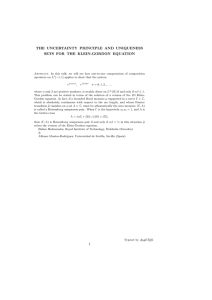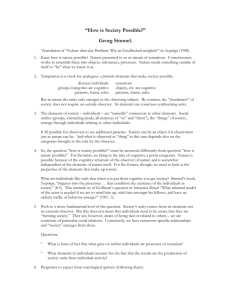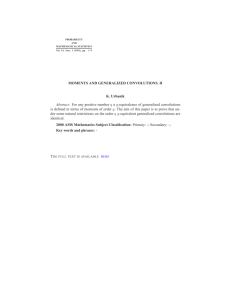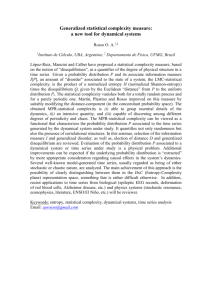ON MEASURE SOLUTIONS TO THE ZERO-PRESSURE GAS MODEL AND THEIR UNIQUENESS
advertisement
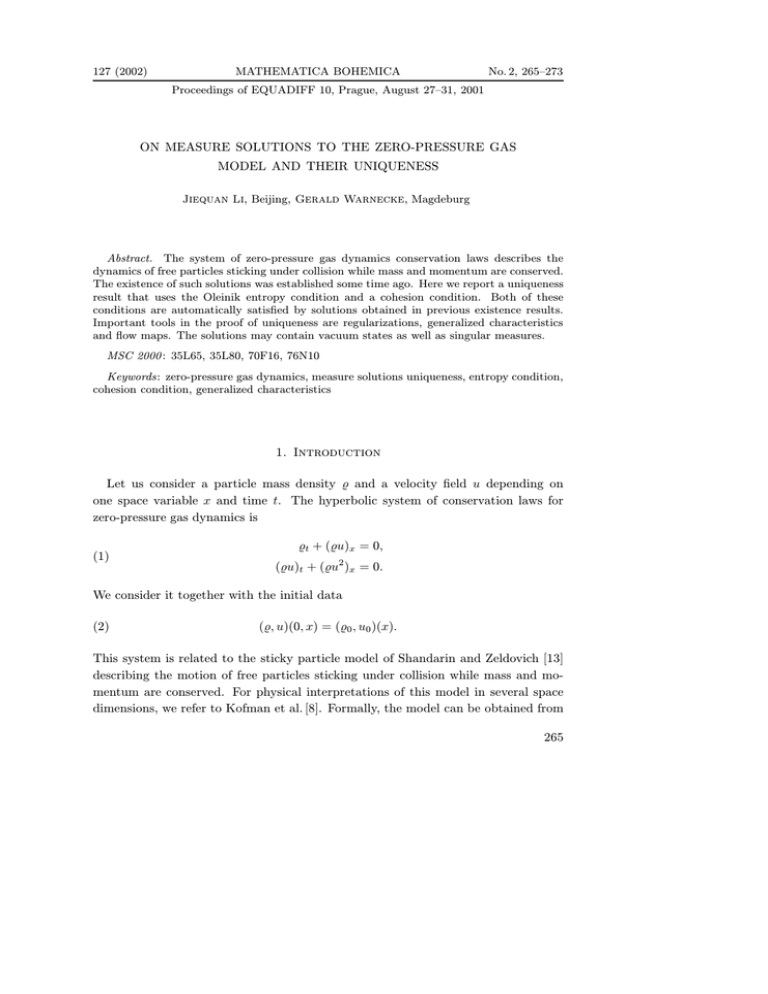
127 (2002)
MATHEMATICA BOHEMICA
No. 2, 265–273
Proceedings of EQUADIFF 10, Prague, August 27–31, 2001
ON MEASURE SOLUTIONS TO THE ZERO-PRESSURE GAS
MODEL AND THEIR UNIQUENESS
Jiequan Li, Beijing, Gerald Warnecke, Magdeburg
Abstract. The system of zero-pressure gas dynamics conservation laws describes the
dynamics of free particles sticking under collision while mass and momentum are conserved.
The existence of such solutions was established some time ago. Here we report a uniqueness
result that uses the Oleinik entropy condition and a cohesion condition. Both of these
conditions are automatically satisfied by solutions obtained in previous existence results.
Important tools in the proof of uniqueness are regularizations, generalized characteristics
and flow maps. The solutions may contain vacuum states as well as singular measures.
MSC 2000 : 35L65, 35L80, 70F16, 76N10
Keywords: zero-pressure gas dynamics, measure solutions uniqueness, entropy condition,
cohesion condition, generalized characteristics
1. Introduction
Let us consider a particle mass density and a velocity field u depending on
one space variable x and time t. The hyperbolic system of conservation laws for
zero-pressure gas dynamics is
(1)
t + (u)x = 0,
(u)t + (u2 )x = 0.
We consider it together with the initial data
(2)
(, u)(0, x) = (0 , u0 )(x).
This system is related to the sticky particle model of Shandarin and Zeldovich [13]
describing the motion of free particles sticking under collision while mass and momentum are conserved. For physical interpretations of this model in several space
dimensions, we refer to Kofman et al. [8]. Formally, the model can be obtained from
265
the compressible Euler equations by taking the pressure to zero or from the Boltzmann equation by letting the temperature go to zero, see Bouchut [2]. A rigorous
proof of the reduction from the Euler equations to the system (1) taking account of
the structure of solutions can be found in Li [9]. The system (1) was also related to
scalar conservation laws and even to Hamilton-Jacobi equations in Brenier and Grenier [3]. In a class of fractional step methods for gas dynamics one splits evolution
operators. For instance one may split the system of compressible Euler equations
into the zero-pressure model, we are considering here, and the pressure gradient flow,
see Agarwal and Halt [1] or Li and Cao [10].
The system (1) is non-strictly hyperbolic with the velocity u as a double eigenvalue.
For smooth solutions it is easily seen that the system decouples in the following
manner. Using the first equation, the second equation becomes the well understood
2
Burgers equation ut + ( u2 )x = 0. Solving it first and then using the known velocity
u, the first equation for the non-negative mass density is then solved as a scalar
equation, too.
The density may develop into a singular measure, even when the initial data are
regular. The weak solution in the sense of distributions is not a function, possibly discontinuous, anymore but must be considered in the sense of signed measures.
These will be a measure m for the density and a signed measure I for the momentum u, which is the other conserved dependent variable. We also allow the mass
density to vanish. This is the vacuum state. The velocity makes physical sense only
when mass is present. Therefore the momentum will be assumed to be absolutely
continuous with respect to the mass measure.
Definition 1. We denote by B the σ-algebra of Borel measurable subsets of Ê
and by M(Ê) the space of signed Borel measures on Ê. Take m, I ∈ L∞ (Ê+ , M(Ê)),
i.e. assume that (m, I)(t, ·) are signed Borel measures on Ê for any t ∈ [0, ∞[. By
(m, I)(t, ∆) we denote the signed measure of the Borel measurable set ∆ ∈ B at time
t ∈ Ê+ = [0, ∞[.
Further, let the measure I(t, ·) for the momentum be absolutely continuous with
respect to the measure for the particle mass density m(t, ·). Then a velocity u(t, x)
can be defined using the Radon-Nikodym Theorem as the density function given by
(3)
u(t, x) =
dI
,
dm
i.e.
u dm.
dI =
∆
∆
For clarity we also use the notation m(t, dx) := dm and I(t, dx) := dI. We say
of the system (1)
that a pair of signed measures (m, I) is a
266
for the initial data (2) if and only if the equations
[ϕt m(t, dx) + ϕx I(t, dx)] dt +
(4)
Ê+×Ê
∞
−∞
∞
ϕ(0, x)m(0, dx) = 0,
[(ϕt + ϕx u(t, x))I(t, dx)] dt +
Ê+×Ê
−∞
ϕ(0, x)I(0, dx) = 0
are satisfied for all ϕ ∈ C ∞ (Ê+ × Ê).
Based on this definition, the Cauchy problem was solved in Cheng et al. [4]. For
an alternative proof see [6]. For the initial data one may either consider locally finite
measures or one needs a boundedness condition in case the initial mass does not have
a compact support, see [4].
2. Uniqueness
For weak solutions to conservation laws it is well-known that some additional
entropy condition is needed in order to obtain the uniqueness of solutions. It selects
the physically relevant solution for given initial data. From the existence proof in [4],
[6] one may see: The solutions constructed there automatically satisfy the classical
There exists a constant E > 0 such that
(5)
E
u(t, x + a) − u(t, x)
a
t
for all x ∈ Ê, a > 0 and t ∈]0, ∞[.
This condition is sufficient to prove uniqueness for the case of the Burgers equation,
see Smoller [12]. For the system (1) the following simple counterexample shows that
an additional condition must be imposed. Take δ0 to be the Dirac point measure
with unit mass at zero and u to be any constant. Let (2) be the simple initial state
(m0 , I0 )(x) = (δ0 , uδ0 ). Basically, the initial data for the velocity are u at x = 0 and
completely arbitrary elsewhere because the mass density vanishes. We can construct
an infinite family of solutions in the follwing manner:
(6)
a , x = a1 t,
1
m(t, ·) := 1 δ(x−a1 t) + 2 δ(x−a2 t) , u(t, x) := a2 , x = a2 t,
0, everywhere else.
We choose constants a1 < a2 as well as 1 , 2 0 in order to have conservation
of mass by taking 1 + 2 = 1 and to have conservation of momentum by setting
1 a1 + 2 a2 = u. These solutions all satisfy Definition 1 and the Oleinik condition.
267
The Oleinik condition is satisfied in the sense that the function u(t, ·) in (6) may
be replaced equivalently almost everywhere with respect to m(t, ·) by a linear interpolant between the values 0, a1 , a2 , 0 that has a maximal slope E/t for an appropriate
constant E, since the values of u on the set where the mass density vanishes may
be chosen arbitrarily. Note that this extension of the Oleinik condition to vacuum
states prevents any further splitting of the mass from occuring at times t > 0. The
slope of any interpolant must become infinite in that case. The factor 1/t in the
Oleinik condition allows this to occur only at t = 0.
However, the Oleinik condition does not reflect the fact that massive particles
represented by a singular measure should never separate, not even initially. The
above example motivates the following condition suggested by the first author.
For x0 ∈ Ê, if m0 ({x0 }) > 0, then writing t → 0+
for the limit from above, i.e. using t > 0, we require that
(7)
x − x0
− u0 (x0 ) ε
lim m t, x ∈ Ê; = m0 ({x0 })
t
t→0+
for all ε > 0.
The Oleinik and the cohesion conditions together form an
for measure solutions of the zero-pressure gas dynamics initial value problem
(1) and (2). We point out that the solutions constructed in [4] satisfy this condition
as well. Note further that the cohesion condition prevents the splitting up of singular masses at time t = 0. But not even both the cohesion and Oleinik’s condition
together prevent singular masses from separating from pieces of regular mass at time
t = 0. Similarly one may have also u0 (x− ) < u0 (x+ ) for some x ∈ Ê in the regular
part. Here u0 (x± ) denotes the limits obtained by approaching x from above and
below, respectively. In all allowed cases of initial separation of velocity a vacuum
is created due to the conservation of mass. This is different from the creation of
rarefaction waves for the Burgers equation using the same initial data u0 . At later
times any separation of mass at all is prevented by the Oleinik condition.
In this paper we will highlight the main elements of the uniqueness proof of the
solutions to the system (1) with the initial condition (2) under the restriction of the
above entropy condition. The full details may be found in [11]. The uniqueness
theorem is stated as follows.
Theorem 2 (Uniqueness). Measure solutions to the system (1) under the initial
condition (2) satisfying the entropy condition are unique in the following sense. Assume that (mi , Ii ) for i = 1, 2 are two measure solutions of (1) and (2) satisfying
Definition 1 and the Oleinik condition (5) as well as the cohesion condition (7). Then
268
they are equal, i.e. the equations
(8)
+
Ê ×Ê
ϕm1 (t, dx) dt =
Ê+×Ê
ϕI1 (t, dx) dt =
+
Ê ×Ê
Ê+×Ê
ϕm2 (t, dx) dt,
ϕI2 (t, dx) dt
hold for all bounded test functions ϕ ∈ C ∞ (Ê+ × Ê).
This result completes the program of giving an existence and uniqueness theory
for the initial value problem (1) and (2).
We would like to point out that independently Huang and Wang [7] re-proved
the existence result and gave a uniqueness result for solutions to (1) using a different entropy condition. They utilized the Lebesgue-Stieltjes integral to equivalently
define weak solutions to (1) in terms of the distribution functions of the measures.
Then they proved uniqueness of solutions using techniques quite different from those
outlined here. They studied the adjoint problem and needed a new existence as well
as uniqueness theorem for a linear equation with discontinuous cooefficients. Their
entropy condition consists of the Oleinik condition and an energy condition that
states that the energy should be weakly continuous initially. It must be pointed out
that the sticky particles in this model lose energy immediately under collision as
time evolves, see [2], and so one cannot guarantee that the energy is continuous in
the solution. Therefore, their condition does not reflect a natural property of the
model. Here we use instead the initial cohesion condition which reflects the physical
fact that massive particles never split, not even initially.
3. Generalized characteristics and flow maps
The method of proof for Theorem 2 is basically a method of characteristics for
the entropy solutions given by the existence theory. One has to overcome two main
difficulties in extending the concept of generalized characteristics to the system (1).
One is the possible presence of vacuum states in the solutions, where no velocity is
specified. The other is the irregularity of solutions, i.e. the solutions are not necessarily functions of bounded variation but may contain singular measures. For this
purpose, we first regularize the entropy solutions so that the generalized characteristics, see Dafermos [5], for the regularized solutions are well-defined in the usual sense.
Then generalized characteristics for the irregular problem are obtained in the limit
of the vanishing regularization parameter. An important tool in the analysis are the
characteristic maps which are flow maps of the flow generated by the generalized
characteristics. It is shown that they naturally satisfy the properties of conservation
269
of mass and momentum, which is to be expected. Further, the dynamic behaviour
of the center of mass of sets, subjected to the characteristic maps in time, is studied.
The results thus obtained finally lead to our uniqueness proof. As a by-product, we
also verify the Generalized Variational Principle used in [6].
The regularization procedure is rather technical. First note that the mass m is
always a nonnegative measure. Using the Galilean invariance of the system, i.e. going
to a reference frame moving with the largest negative velocity, one may assume all
velocities to be nonnegative. This implies that the momentum I may also be assumed
to be nonnegative. It means that some proofs concerning properties of I are identical
to those for m. The distribution functions of the measures for mass m and momentum
I are regularized by a suitable space-time averaging. It can be shown that the limit
of taking the regularization parameter to zero gives a measure equivalent to the
original one, for details see [11].
The generalized characteristics are Lipschitz curves that are generalized solutions
to the ordinary differential equation dx
dt = u(t, x) for the double eigenvalue u. If u is
a smooth function, they are just the forward in time solution curves of this ordinary
differential equation through the point (t0 , x0 ) denoted by x = x0 (s; t0 , x0 ), s t0 .
Here these notions are not only extended to the well known case where u has jumps,
see Dafermos [5], but also to the case of characteristics near a vacuum state or a
singular measure. For this purpose the velocity function u has to be extended into
the vacuum by linear interpolation or extension and then regularized. This has to
be done in a manner compatible with the Oleinik condition. As a result one can
determine the generalized characteristics in the regularized situation. The extended
generalized characteristics needed here are then obtained by taking uniform limits
for the vanishing regularization parameter, see [11]. For all τ > 0 and x0 ∈ Ê, these
extended generalized characteristic curves x = x0 (t) = x0 (t; τ, x0 ) with x0 (τ ) = x0
0
again satisfy the differential equation dxdt+(t) = u(t, x0 (t)) almost everywhere with
respect to m(t, ·). The derivative dtd+ denotes the one-sided derivative from above
in time.
The generalized characteristic curves x = x0 (s; t0 , x0 ), s t0 , once defined, allow
or
the introduction of the family of
(9)
x = ht0 ,s (x0 ) = x0 (s; t0 , x0 ),
s t0 .
Also needed are the inverse maps h−1
t0 ,s which are not always proper inverses as
point mappings, because mass can accumulate. They may be set valued mappings,
i.e. the image h−1
t0 ,s (x) may be a set. Due to this property one may prefer to think of
characteristic maps as maps between subsets of Ê from the outset. If the solution
contains vacuum states the set h−1
t0 ,s (x) may have gaps. In this case we add these
270
gaps to h−1
t0 ,s (x) so that the set will always be an interval. Important properties of
the flow maps proved in [11] are given in the following lemma.
Lemma 3. The maps ht0 ,t :
more, they satisfy
Ê → Ê are non-decreasing and continuous.
Further-
ht1 ,t3 (x) = ht2 ,t3 ht1 ,t2 (x)
(10)
for all τ t1 t2 t3 T .
Further, one can prove
Theorem 4. For all bounded measurable functions ϕ : Ê →
conservation of mass
∞
∞
(11)
ϕ(x)m(T, dx) =
ϕ(hτ,T (x))m(τ, dx)
−∞
Ê
we have the
−∞
for all 0 τ < T < ∞.
This theorem directly leads to the following conservation of mass and momentum
property. For all Borel sets A ∈ B and T > τ we have
(12)
m(T, A) = m(τ, h−1
τ,T (A)),
I(T, A) = I(τ, h−1
τ,T (A)).
An important concept for our analysis is the center of mass of a set and its dynamic
of a Borel set a ∈ B by
behavior. We denote the first
(13)
Then the
(14)
K(t, A) :=
A
ξm(t, dξ),
t 0.
of a set A ∈ B with m(t, A) > 0 is defined as
M (t, A) :=
K(t, A)
.
m(t, A)
Consider a point x such that m(t, {x}) = 0 but the measure does not vanish in any
open neigborhood of x, i.e. x does not lie in the vacuum. Then we can still define the
center of mass for the one point set {x} = A. Note that by the Lebesgue Theorem
one has M (t, A) = x for a Lebesgue point x by taking the limit of the center of
mass on open neighborhoods of x. This holds almost everywhere in the sense of the
Lebesgue measure. We may assume that this holds everywhere in the complement
of the vacuum set.
271
The following formula gives the shift of the center of mass of a set under the flow
map due to the characteristic velocity. For all A ∈ B, if m(t, A) > 0 and t τ , then
(15)
M (t, A) =
h−1
τ,t (A)
(ξ + (t − τ )u(τ, ξ))m(τ, dξ)
.
h−1 (A) m(τ, dξ)
τ,t
For the
notation
of any Borel set B ∈ B we introduce the
(16)
C(B; τ, t) :=
B
[ξ + (t − τ )u(τ, ξ)]m(τ, dξ)
.
m(τ, dξ)
B
This quantity tells us where the center of mass of the set B considered at time τ
would be at a later time t, provided the generalized characteristics originating in B
do not interact with others that start outside B at time τ . Note that the set B here
is not necessarily an image under the map h−1
τ,t as required for the validity of formula
(15). In view of (15) we have M (t, A) = C(h−1
τ,t (A); τ, t).
Let 0 < τ < T < ∞ and y ∈ Ê, and let us set [a, b] := h−1
τ,T (y). Then we
have C([a, b]; τ, T ) = y. One is mostly interested in the case a < b, which means
that generalized characteristics are merging and mass is being accumulated in y.
Taking any x0 ∈ [a, b], one considers the generalized characteristic x0 (t) = x0 (t; x0 , τ )
emerging there. All generalized characteristics originating in the interval [a, b] must
pass through y at time T , i.e. satisfy x0 (T ) = y. The fundamental inequalities
(17)
C([a, x0 ]; τ, T ) y C([x0 , b]; τ, T )
may be proven for all x0 ∈ [a, b]. The possibility that the strict inequality holds
comes from the fact that the sets [a, x0 ] and [x0 , b] are not images under the map
h−1
τ,t unless a = x0 = b.
Let [a(t), b(t)] = h−1
t,T ({y}) for all t ∈ [τ, T ] and y ∈ Ê not in the vacuum set at
time T . Now the uniqueness proof works along the following lines. At time T one
studies the initial intervals [a(0), b(0)] for two solutions to the same initial data that
differ at y. It is then proven via a number of technical results that the parts of the
intervals that are not in their intersection must have mass zero. Assuming that this
is not the case, the behaviour of the center of mass of the difference of the intervals
is studied and a contradiction can be derived. The complications in the proof are
essentially twofold. One is due to the fact that at a(0) and b(0) an initial separation
of mass may occur. The other comes from the fact that the interval [a(0), b(0)] may
contain vacuum sets.
272
. Parts of this work were accomplished during visits of
both authors at the Institute of Mathematics of Hebrew University in Jerusalem,
Israel and the authors are very grateful for the hospitality extended to them. This
work has benefitted from helpful discussions with Matania Ben-Artzi, Tong Zhang
and Hailiang Liu. The work of both authors was partially supported by funding
through the German-Israeli Science Foundation (GIF) grant I-318-195.06/93 and the
DFG-funded ’Graduiertenkolleg Modellierung, Berechnung und Identifikation mechanischer Systeme’ in Magdeburg, Germany.
References
[1] R. K. Agarwal, D. W. Halt: A modified CUSP scheme in wave/particle split form
for unstructed grid Euler flow. Frontiers of Computational Fluid Dynamics 1994
(D. A. Caughey, M. M. Hafez, eds.). Wiley, Chichester, 1995, pp. 155–163.
[2] F. Bouchut: On zero pressure gas dynamics. Advances in kinetic theory and computing,
Series on Advances in Mathematics for Applied Sciences 22, World Scientific, Singapore,
1994, 171–190.
[3] Y. Brenier, E. Grenier: Sticky particles and scalar conservation laws. SIAM J. Numer.
Anal. 35 (1998), 2317–2328.
[4] S. Cheng, J. Li, T. Zhang: Explicit construction of measure solutions of the Cauchy problem for the transportation equations. Science in China, Series A 40 (1997), 1287–1299.
[5] C. M. Dafermos: Generalized characteristics in hyperbolic systems of conservation laws.
Arch. Rat. Mech. Anal. 107 (1989), 127–155.
[6] W. E, Yu. G. Rykov, Ya. G. Sinai: Generalized variational principles, global weak solutions and behavior with random initial data for systems of conservation laws arising in
adhesion particle dynamics. Comm. Math. Phys. 177 (1996), 349–380.
[7] F. Huang, Z. Wang: Well posedness for pressureless flow. Preprint. Institute of Applied
Mathematics, the Chinese Academy of Sciences, 2001.
[8] L. Kofman, D. Pogosyan, S. Shandarin: Structure of the universe in the two-dimensional
model of adhesion. Mon. Nat. R. Astr. Soc. 242 (1990), 200–208.
[9] J. Li: Note on the compressible Euler equations with zero temperature. Appl. Math.
Lett. 14 (2001), 519–523.
[10] Y. Li, Y. Cao: Second order “large particle” difference method. Sciences in China 8
(1985). (In Chinese.)
[11] J. Li, G. Warnecke: Generalized characteristics and the uniqueness of entropy solutions to zero-pressure gas dynamics. Preprint 01-7, Fakultät für Mathematik,
Otto-von-Guericke-Universität Magdeburg. Submitted for publication.
[12] J. Smoller: Shock Waves and Reaction-Diffusion Equations. Springer, New York, 1983.
[13] S. F. Shandarin, Ya. B. Zeldovich: The large-scale structure of the universe: Turbulence,
intermittency, structures in a self-gravitating medium. Rev. Mod. Phys. 61 (1989),
185–220.
Authors’ addresses: Jiequan Li, Institute of Mathematics, Academia Sinica, Beijing,
100080, P. R. China, e-mail: jiequan@math.sinica.edu.tw; Gerald Warnecke, Institut für
Analysis und Numerik, Otto-von-Guericke-Universität Magdeburg, Postfach 4120, 39016
Magdeburg,Germany, e-mail: gerald.warnecke@mathematik.uni-magdeburg.de.
273
